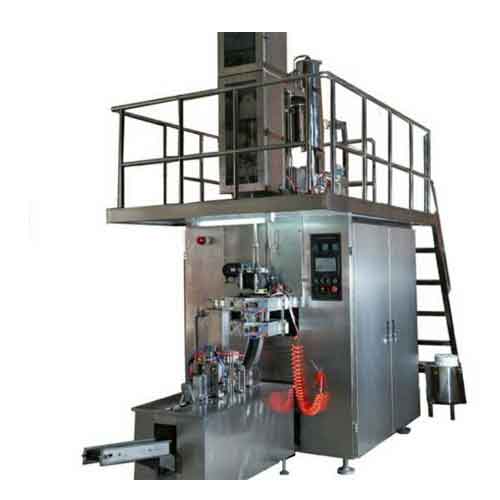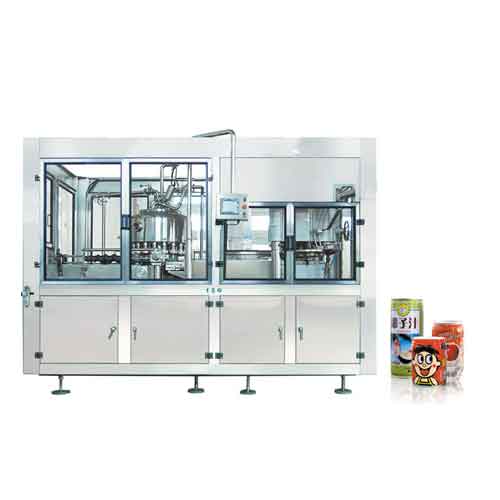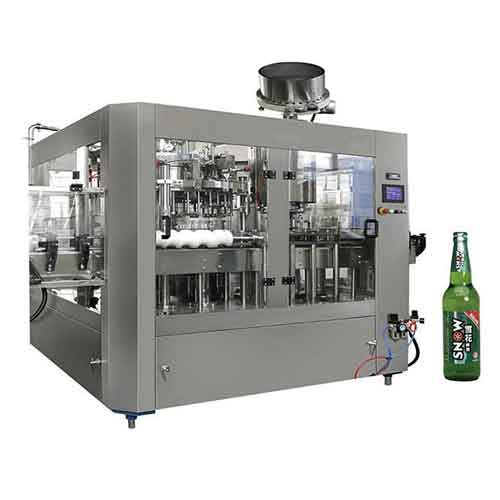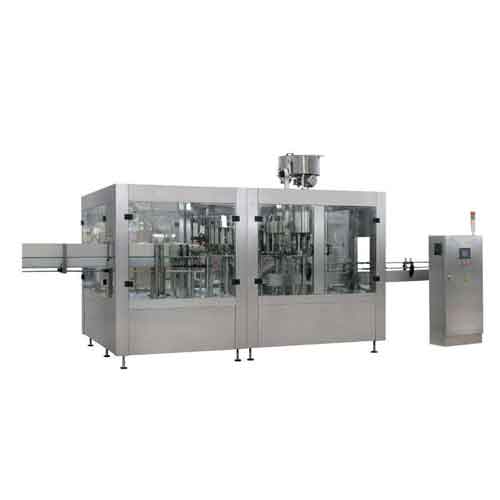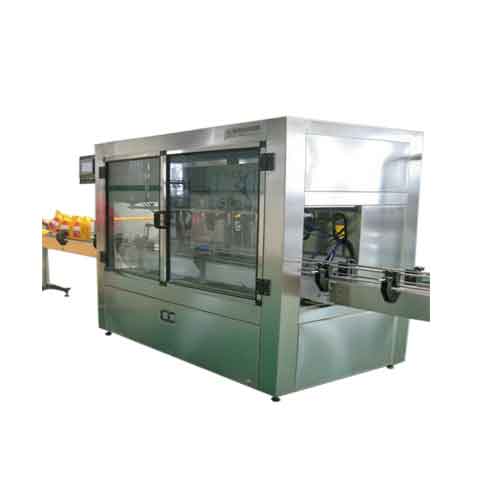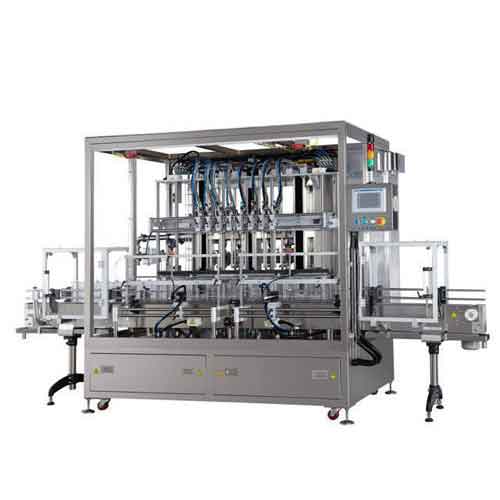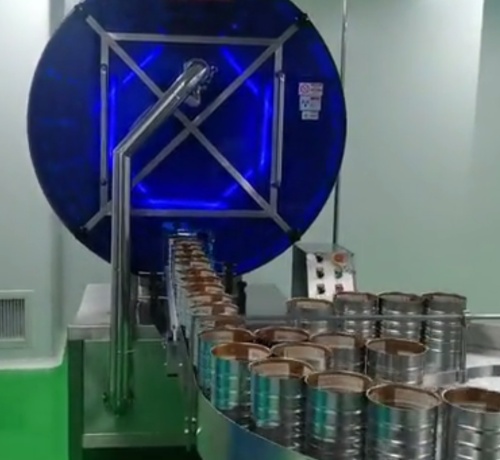
1. Technical characteristics of non-magnetic empty tank cleaning and disinfection machine
The non-magnetic empty can cleaning and disinfection machine is a supporting equipment for powder filling production lines, mainly used for disinfection and cleaning of empty cans. Its design aims to improve cleaning efficiency, avoid the drawbacks of traditional magnetic cleaning methods, and ensure food safety and hygiene standards.
Core technical features:
Non magnetic cleaning design:
- Adopting a patented structure design that integrates rotary cleaning and ultraviolet disinfection, there is no need for traditional magnets to adsorb impurities such as iron filings, avoiding the problem of incomplete cleaning of metal foreign objects caused by strong magnetic attraction during the can flipping process.
- Non magnetic design allows for more thorough cleaning of metal objects inside the tank, especially suitable for cleaning non-magnetic or weakly magnetic metal (such as certain stainless steel) contaminants that are difficult to remove with traditional magnetic separators.
- Ultrasonic cleaning equipment usually uses non-magnetic stainless steel tanks to achieve all-round cleaning through reflected sound waves.
Compact structure and versatility:
- Compact design, with a small footprint, facilitating integration into existing production lines.
- By changing the molds, it can clean various specifications of round containers, suitable for containers made of glass, metal, plastic, and composite materials, among others.
Integrated cleaning and disinfection:
- UV disinfection and cleaning are completed in one workstation, avoiding the risk of secondary pollution caused by traditional cleaning and disinfection separation.
- The equipment integrates empty tank transportation, purification, blowing, cleaning, and ultraviolet sterilization and disinfection, with a compact and efficient process.
High efficiency and automation:
- The disinfection speed can reach 1-45 cans/minute (frequency conversion control), with high production efficiency.
- Some equipment has automatic cleaning function, which can continuously and efficiently remove pollutants without manual intervention from the operator.
Compliant with hygiene standards:
- The main material is SUS304 stainless steel, which meets the material requirements of food grade equipment.
- UV disinfection complies with relevant guidelines to ensure the effectiveness of drinking water disinfection.
- The equipment design follows the 3-A hygiene standard to ensure a smooth and easy to clean surface, preventing the accumulation of pollutants.
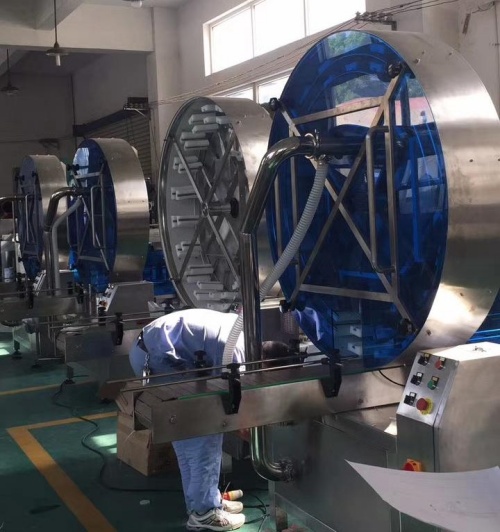
2. Common Fault Types and Causes
| Fault type | Common Causes |
| Device Cannot Start/No Power Supply |
-The power cord is not properly connected or the socket is dead. -Internal electrical issues (such as blown fuses, damaged circuit boards). -The emergency stop button has been pressed. |
| Poor Cleaning Effect / Decreased Efficiency |
-The can specifications do not match the mold. -Insufficient supply or quality issues of cleaning media (such as water, cleaning agents). -The nozzle is blocked or worn. -The aging, damage, or surface contamination of ultraviolet lamps result in insufficient disinfection intensity. -The cleaning area has stubborn dirt that is difficult to remove. |
| Can Transportation Issues |
-The conveyor belt slips, wears, or is damaged. -Cans stuck or overturned. -Sensor malfunction leads to poor delivery. -Transmission components (such as motors and reducers) malfunction. |
| Abnormal Noise / Excessive Vibration |
-Bearing wear or insufficient lubrication. -Loose fasteners. -Misalignment of transmission components. -Foreign objects inside the equipment. |
| Control System Failure |
-The control panel is damaged or the buttons are malfunctioning. -The sensor reading is incorrect. -Software program error or improper parameter settings. -Electrical components (such as relays and contactors) malfunction. |
| Liquid Leakage |
-Loose pipeline connections or aging and damaged seals. -Pump body or valve malfunction. -Cracks appear on the cleaning can body. |
| Overheating Issue |
-The motor or electrical components work continuously for a long time and have poor heat dissipation. -Excessive load. -Cooling system malfunction (such as blocked fans and heat sinks). |
| Abnormal UV Disinfection |
-The lifespan of the ultraviolet lamp tube has expired or is damaged. -UV sensor malfunction, unable to accurately detect intensity. -UV system control circuit malfunction. |
3. Fault Diagnosis and Solutions
For the aforementioned common faults, the following provide detailed diagnostic procedures and solutions to assist customers in quickly restoring the operation of the equipment.
Fault Diagnosis and Solutions:
| Fault phenomenon | Diagnosis steps | Solution |
| Device Cannot Start/No Power Supply |
1. Check if the power connection is secure and if the socket has power. 2. Check if the emergency stop button has been pressed and reset. 3. Check if the fuse inside the control cabinet is blown. 4. Check if the main power switch and circuit breaker have tripped. 5. Check if there are indicator lights on the control board. |
1. Reconnect the power supply and ensure normal power supply. 2. Reset the emergency stop button. 3. Replace the blown fuse. 4. Reset the circuit breaker. 5. If the control board does not respond, professional personnel may need to check the internal electrical connections or replace the control board. |
| Poor Cleaning Effect / Decreased Efficiency |
1. Check if the current can specifications match the equipment mold. 2. Check if the cleaning fluid level, pressure, and temperature meet the requirements. 3. Check if there are any signs of blockage or wear on the nozzle. 4. Check if the ultraviolet lamp is on and if there is dust or scale on the surface. 5. Check if the UV intensity meter reading is normal (if any). |
1. Replace the matching molds. 2. Add cleaning solution, adjust pressure and temperature. 3. Clean or replace clogged/misshapen nozzles. 4. Clean the surface of the lamp tube. If the lamp tube is not bright or insufficient in strength, replace the aged or damaged ultraviolet lamp tube. 5. Regularly calibrate the ultraviolet measurement equipment (suggested once a year). |
| Can Transportation Issues |
1. Check the tension of the conveyor belt for wear or tear. 2. Check if there are any stuck points or foreign objects in the can during transportation. 3. Check if the conveyor motor and reducer are operating normally and if there are any abnormal noises. 4. Check if the relevant sensors (such as photoelectric sensors) are obstructed or damaged. |
1. Adjust the tension of the conveyor belt and replace it if necessary. 2. Remove stuck foreign objects and check if the conveying path is smooth. 3. Check the motor and reducer, and repair or replace them if necessary. 4. Clean or replace the sensor. |
| Abnormal Noise / Excessive Vibration |
1. Listen to the sound and identify the source of the noise. 2. Check if all visible fasteners are loose. 3. Check if there are signs of wear on the bearings and if lubrication is needed. 4. Check if the transmission components (such as belts and chains) are aligned. |
1. Tighten the loose fasteners. 2. Lubricate the bearings. Replace them if they are severely worn. 3. Adjust the alignment of the transmission components. 4. Shut down the equipment and check if there are any foreign objects inside. Remove them if present. |
| Control System Failure |
1. Check if the control panel buttons are sensitive. 2. Check if the sensor connection wire is loose or damaged. 3. Check the device error code (if any), refer to the operation manual. 4. Check if there is any burning or odor in the electrical components inside the control cabinet. |
1. Clean or replace the control panel. 2. Reconnect or replace the sensor connection wire. 3. Conduct targeted troubleshooting based on the error code, or contact the supplier for technical support. 4. Replace damaged electrical components. |
| Liquid Leakage |
1. Check for any leaks at all pipe joints and valve connections. 2. Inspect the pump body and valve body for cracks or damages. 3. Check for leaks at the weld seams or bottom of the cleaning can. |
1. Tighten the loose joints and replace the worn-out seals. 2. Repair or replace the damaged pump body or valves. 3. If the tank leaks, professional welding repair or replacement is required. |
| Overheating Issue |
1. Check if the cooling fans of heating components such as motors and frequency converters are operating normally. 2. Check if the equipment load exceeds the rated value. 3. Check if the cooling system (such as water-cooled or air-cooled) is blocked or malfunctioning. |
1. Clean the cooling fan to ensure good ventilation. 2. Reduce equipment load or check for excessive mechanical resistance. 3. Clean or repair the cooling system. |
| Abnormal UV Disinfection |
1. Check if the UV lamp is on and if there is any blackening on the appearance. 2. Check if the UV intensity sensor is clean and connected properly. 3. Check the UV power module and control circuit. |
1. Replace UV lamps that have reached the end of their lifespan or are damaged. 2. Clean the surface of the sensor, check and tighten the connecting wires. 3. Contact professionals to inspect or replace power modules and control circuits. |
Preventive maintenance recommendations:
Regular cleaning: Keep the inside and outside of the equipment clean, especially the surface of the ultraviolet lamp and sensor, to prevent dust and scale from affecting performance.
Lubrication inspection: Regularly check the lubrication of moving parts and lubricate them according to the manufacturer's recommendations.
Component inspection and replacement: Regularly inspect the wear of vulnerable parts (such as seals, nozzles, conveyor belts, UV lamps) and replace them according to the plan.
Calibration: Regularly calibrate key measuring equipment, such as ultraviolet intensity meters.
Operation training: Ensure that operators are familiar with the equipment operation manual, understand daily maintenance and simple troubleshooting methods.
Record maintenance logs: Detailed records of each maintenance, inspection, and troubleshooting to track equipment status and predict maintenance needs.
Union Machinery has been engaged in food machinery customization services since its establishment in 2014, according to customer needs for you to tailor suitable machinery and equipment, for more product information, please refer to: Magnetic Free Empty Can Cleaning And Disinfection Machine、Milk Powder Filling Production Line; Our expertise and advantages will bring you more opportunities and development space.
For personalized, industry-tailored advice and to explore state-of-the-art solutions, please don't hesitate to contact us at info@unmachinery.com
The following is other knowledge related to magnetic-free can cleaning and disinfection machine that I have summarized based on long-term work experience, for your reference. I hope it will be helpful to you.
1.What Are the Working Principles and Functions of a Magnetic-Free Empty Can Cleaning and Disinfection Machine?
2.How to Maintain and Service a Non-Magnetic Empty Can Cleaning and Disinfecting Machine?

